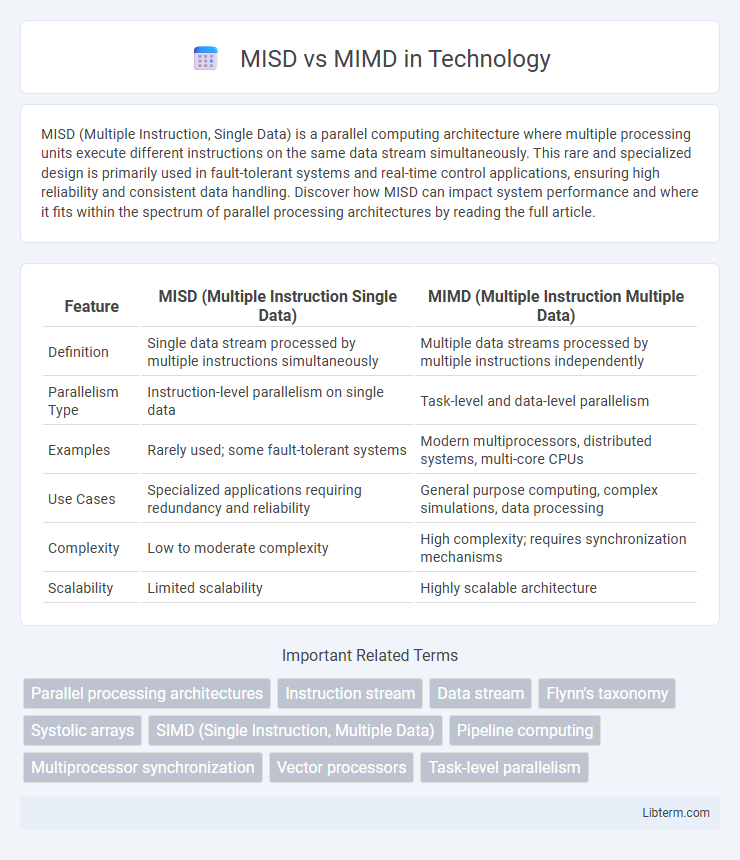MISD (Multiple Instruction, Single Data) is a parallel computing architecture where multiple processing units execute different instructions on the same data stream simultaneously. This rare and specialized design is primarily used in fault-tolerant systems and real-time control applications, ensuring high reliability and consistent data handling. Discover how MISD can impact system performance and where it fits within the spectrum of parallel processing architectures by reading the full article.
Table of Comparison
| Feature | MISD (Multiple Instruction Single Data) | MIMD (Multiple Instruction Multiple Data) |
|---|---|---|
| Definition | Single data stream processed by multiple instructions simultaneously | Multiple data streams processed by multiple instructions independently |
| Parallelism Type | Instruction-level parallelism on single data | Task-level and data-level parallelism |
| Examples | Rarely used; some fault-tolerant systems | Modern multiprocessors, distributed systems, multi-core CPUs |
| Use Cases | Specialized applications requiring redundancy and reliability | General purpose computing, complex simulations, data processing |
| Complexity | Low to moderate complexity | High complexity; requires synchronization mechanisms |
| Scalability | Limited scalability | Highly scalable architecture |
Understanding Processor Architectures: MISD and MIMD
MISD (Multiple Instruction, Single Data) architecture processes multiple instructions on the same data stream, often used in fault-tolerant systems and real-time applications. MIMD (Multiple Instruction, Multiple Data) architecture supports parallel processing by executing different instructions on separate data, commonly found in multicore processors and distributed computing. Both MISD and MIMD are critical in understanding the diversity of parallel computing models and optimizing performance for complex computational tasks.
What is MISD? Definition and Key Concepts
MISD (Multiple Instruction Single Data) is a parallel computing architecture where multiple processing units execute different instructions simultaneously on the same data stream. This model is rarely used in practice but is primarily applied in specialized systems such as fault-tolerant or pipeline processing environments. Key concepts of MISD include concurrent instruction execution, single data input, and redundancy for increased reliability.
What is MIMD? Definition and Key Features
MIMD (Multiple Instruction, Multiple Data) is a parallel computing architecture where multiple processors execute different instructions on different data streams simultaneously. Key features of MIMD include independent control processors, asynchronous operation, and suitability for complex, large-scale computations such as multi-tasking and distributed systems. This architecture enables high flexibility and scalability, making it ideal for applications requiring concurrent processing of diverse tasks.
MISD vs MIMD: Core Differences
MISD (Multiple Instruction Single Data) processes multiple instructions on the same data stream, aiming for fault tolerance and redundancy, but is rarely used in practical systems. MIMD (Multiple Instruction Multiple Data) executes different instructions on different data simultaneously, enabling parallel processing and improving performance in multiprocessor systems. The core difference lies in MISD's focus on instruction diversity over the same data versus MIMD's parallelism with diverse instructions and data.
Advantages of MISD Architecture
MISD architecture offers enhanced fault tolerance by processing multiple redundant data streams simultaneously, making it ideal for critical systems like aerospace control. Its parallel processing of identical instructions on different data enhances reliability and error detection. This setup allows for real-time monitoring and ensures system integrity in high-stakes environments where accuracy is paramount.
Benefits of MIMD Architecture
MIMD architecture supports multiple processors executing different instructions on different data streams simultaneously, significantly enhancing parallel processing capabilities and overall system throughput. Its flexibility allows efficient handling of diverse and complex computational tasks, making it ideal for multi-core and distributed systems. This scalability and adaptability result in improved performance for applications such as scientific simulations, real-time processing, and large-scale data analysis.
Real-World Applications of MISD
MISD (Multiple Instruction Single Data) architectures are rare but find niche applications in fault-tolerant systems and real-time safety-critical environments such as aerospace control systems, where multiple processing units execute different instructions on the same data stream to ensure accuracy and reliability. Examples include redundant computation in spacecraft avionics and nuclear reactor monitoring systems, where continuous error detection and correction are essential. These specialized uses exploit MISD's ability to enhance system robustness through parallel instruction paths on single data inputs.
Real-World Applications of MIMD
MIMD (Multiple Instruction Multiple Data) architectures enable parallel processing by allowing multiple processors to execute different instructions on different data simultaneously, making them ideal for real-world applications such as scientific simulations, weather forecasting, and complex numerical computations. Unlike MISD (Multiple Instruction Single Data), which is rare and mainly theoretical, MIMD systems are widely used in supercomputers, multi-core processors, and distributed computing environments to efficiently handle diverse and large-scale tasks. These systems improve performance and scalability in fields requiring intensive data analysis and multitasking capabilities.
Performance Comparison: MISD vs MIMD
MISD (Multiple Instruction, Single Data) architectures offer limited practical performance benefits due to their complexity and rarity in real-world applications, often used in niche fault-tolerant systems. MIMD (Multiple Instruction, Multiple Data) architectures excel in parallel processing, enabling significant performance improvements in multi-core processors and distributed systems through concurrent execution of different instructions on multiple data sets. MIMD's scalability and flexibility result in superior overall performance compared to MISD, particularly in high-performance computing and large-scale data processing environments.
Which Architecture to Choose: MISD or MIMD?
Choosing between MISD (Multiple Instruction Single Data) and MIMD (Multiple Instruction Multiple Data) architectures depends on application requirements and parallelism needs. MISD systems are rare and suited for fault-tolerant or redundant computations, where the same data undergoes different instructions, while MIMD architectures support concurrent execution of distinct instructions on separate data sets, ideal for complex, large-scale parallel processing tasks. For general-purpose parallel computing, MIMD is preferred due to its flexibility and scalability in handling diverse workloads.
MISD Infographic

 libterm.com
libterm.com